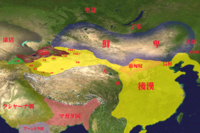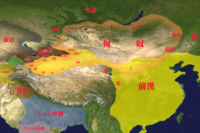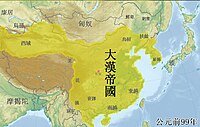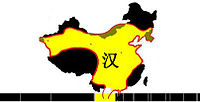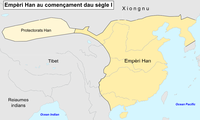Protectorate of the Western Regions
| Protectorate of the Western Regions | |||||||||
|---|---|---|---|---|---|---|---|---|---|
| Traditional Chinese | 西域都護府 | ||||||||
| Simplified Chinese | 西域都护府 | ||||||||
| |||||||||
| History of Xinjiang |
|---|
 |
The Protectorate of the Western Regions was a regional government established by the Han dynasty to manage and to control the Western Regions, roughly today's Xinjiang (excluding Dzungaria).[1]
During the Han–Xiongnu War, the Chinese established a military seat at Wulei, north east of present-day Bugur with an aim to protect the Indo-European Tocharian statelets of the region and kept them away from the Xiongnu's aggression in the northeastern steppe. It is believed to be the first Chinese sign of direct rule of Central Asia.[1][2] The seat was later shifted to Tagan, at around modern Kucha during the Eastern Han.[3]
First set up in 60 BC, it was the highest military position in the west during its existence. During its peak in 51 BC, the Wusun nation was brought under submission.[2] After at least 18 different protector generals, of whose names only 10 of their names are known, the post was abandoned, by the time of Wang Mang's Xin dynasty, until Emperor Ming of Han and his successor awarded the position (now with administrative obligations as well) to general Chen Mu, in 74, and subsequently to Ban Chao, with his successful conquest of the region. On July 29, 107, a series of Qiang's uprisings in the areas of Hexi Corridor and Guanzhong forced the abandonment the post, but was assumed under the Chief Official of the Western Regions later.[3]
Coins with both Chinese and Karoshthi inscriptions have been found in the southern Tarim Basin.[4]
Maps
On some maps the Protectorate of the Western Regions is shown in a lighter version of the color that the Han dynasty is represented in to signify its status as a protectorate.
-
Han dynasty in 1 AD.
-
Han dynasty in 1 AD.
-
Russian map showing Xinjiang as a protectorate of the Han in pink color.
-
Xinjiang as a protectorate of the Han dynasty in light orange color.
-
Xinjiang as a protectorate of the Han dynasty in light orange color.
-
Han dynasty
-
Xinjiang as a protectorate of the Han dynasty in light orange color.
-
Xinjiang as a protectorate of the Han dynasty in light orange color.
-
Map showing how the territories of the Han dynasty and xiongnu overlapped at different time periods.
-
Han dynasty.
-
Han dynasty.
-
Japanese map of Eastern Han dynasty.
-
French map showing the Han dynasty and its protectorate in Xinjiang.
-
Han dynasty in 1 AD.
-
Cities of the protectorate.
List of protector generals
Western Han and Xin
- Zheng Ji 60-48 BCE
- Han Xuan (韓宣) 48-45 BCE
- Anonymous (3rd) 45-42 BCE
- Anonymous (4th) 42-39 BCE
- Anonymous (5th) 39-36 BCE
- Gan Yanshou (甘延壽) 36-33 BCE
- Duan Huizong (段會宗) 33-30, 21-18 BCE
- Lian Bao (廉褒) 30-27 BCE
- Anonymous (9th) 27-24 BCE
- Han Li (韓立) 24-21 BCE
- Anonymous (11th) 18-15 BCE
- Guo Shun (郭舜) 15-12 BCE
- Sun Jian (孫建) 12-9 BCE
- Anonymous (14th) 9-6 BCE
- Anonymous (15th) 6-3 BCE
- Anonymous (16th) 3 BCE-1 CE
- Dan Qin (但欽) 1-13 CE
- Li Chong 13-23 CE
Eastern Han
In popular culture
Dragon Blade, a 2015 film starring Jackie Chan and John Cusack, tells the story of one of the commanders (Chan) of the Protectorate of the Western Regions, who after being framed and sentenced to hard labour at one of the frontier fortresses, and strives to keep the peace among members of the various nations. He befriends a Roman legionary (Cusack) fleeing along the Silk Road, and his desire for peace and non-violence conflicts with his sense of honor and desire to save his new friend.
See also
Notes
- ^ a b "Xiyu Duhu"
- ^ a b Yu 2003, 57-59
- ^ a b Yu 1995, 56, 68-71
- ^ James A. Millward (2007). Eurasian Crossroads: A History of Xinjiang. Columbia University Press. pp. 23–. ISBN 978-0-231-13924-3.
References
- Ma, Yong, "Xiyu Duhu" ("Protector General of the Western Regions"). Encyclopedia of China (Chinese History Edition), 1st ed.
- Yu, Taishan. A Study of the History of the Relationship Between the Western and Eastern Han, Wei, Jin, Northern and Southern Dynasties and the Western Regions. Chinese Academy of Social Sciences, June 1995. Sino-Platonic Papers, Oct, 2006.
- Yu, Taishan (2nd ed, 2003). A Comprehensive History of Western Regions. Zhengzhou: Zhongzhou Guji Press. ISBN 7-5348-1266-6.
External links






